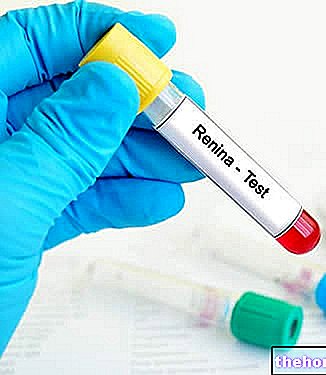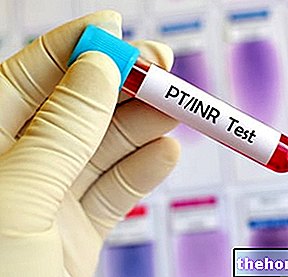Generality
The total iron binding capacity (TIBC, from the "English"Total Iron Binding Capacity”) Is a parameter that indicates how much plasma proteins are able to bind this element and transport it in the bloodstream.
Since transferrin (Tf) is the main plasma protein with binding capacity for iron, TIBC values can be established to indirectly determine its levels in the blood.

What's this
Transferrin is the main transport protein in the blood of oxidized iron (Fe3 +).
In the blood, Tf can be found both in free form (unsaturated transferrin, i.e. not bound to iron), and in iron bound form (saturated transferrin). The share of the latter coincides with the value of the iron.
The amount of transferrin available for iron binding and transport is reflected in the measurement of total iron binding capacity (TIBC), latent iron binding capacity or transferrin saturation.
More specifically, TIBC is the indirect measure of the transferrin's ability to bind iron. Although transferrinemia and TIBC are two different tests, they have an overlapping trend and essentially the same clinical significance. Therefore, at the discretion of the physician, it may be sufficient to carry out only one of the two tests.
Because it is measured
Total iron binding capacity (TIBC) is a test prescribed in patients with suspected iron metabolism abnormalities.
This analysis serves to determine the body's ability to transport the mineral. Since transferrin is the main iron-binding protein, the measurement of TIBC is a good approximation of the available Tb measurement.
TIBC is generally evaluated together with the determination of iron and ferritin, to have a more complete picture of iron metabolism.
Normal values
Normal values of total iron binding capacity vary between 240 and 450 μg / dL (43.0-80.6 μmol / L).
The relationship between sideremia and TIBC defines the saturation of transferrin, a figure usually expressed as a percentage.
- Transferrin saturation = (sideremia / TIBC) x 100
- Normal values for men: 20-50%
- Normal values for women: 15-50%
High TIBC - Causes
Elevated TIBC values usually indicate iron deficiency associated with:
- Bleeding (including occult ones);
- Sideropenic anemias;
- Hypoxemic states;
- Use of oral contraceptives.
An increase in the total capacity to bind iron can also occur during pregnancy (increases in values are also typical in the third trimester of gestation), during breastfeeding and in the child during growth.
Low TIBC - Causes
Low values of TIBC can be found in case of:
- Hemochromatosis;
- Some types of anemia due to the accumulation of iron;
- Malnutrition;
- Acute and chronic inflammatory states;
- Inflammation;
- Liver disease (such as cirrhosis, hepatitis, liver failure) or kidney disease (such as nephrotic syndrome, due to the loss of protein in the urine);
- Chloramphenicol or ACTH therapy.
How it is measured
To perform the total iron binding capacity test, the patient must undergo a blood sample.
Preparation
Venous blood sampling to determine TIBC is usually done in the morning. Before undergoing the examination, the patient must fast for at least 8 hours. During this period, a moderate amount of water is allowed. Furthermore, it is recommended that iron supplements be discontinued in the two days preceding the analyzes.
Interpretation of Results
- Low TIBC can lead to suspicion of iron overload, as occurs with repeated transfusions or in hemochromatosis. Reduced values can also be found in the presence of anemia caused by chronic inflammatory diseases and infections, malnutrition, liver cirrhosis or nephrotic syndrome. lowering of the values is also observable for the intake of the hormone ACTH and the antibiotic chloramphenicol or during the use of cortisone.
- High TIBC generally indicates a deficiency or increased need for iron, such as in the case of bleeding, iron deficiency anemia, or hypoxemia. Even oral contraceptives or pregnancy can induce an increase in the parameter.
However, it should be reiterated that this test must be interpreted in an overall view of the tests concerning the metabolism of iron in the body. For example, in "iron deficiency anemia (ie iron deficiency), an" initial reduction in ferritin is observed, followed by an increase in total iron-binding capacity and a reduction in sideremia.
saturated
iron
Select Blood Tests Blood Tests Uric acid - uricaemia ACTH: adrenocortitotropic hormone Alanine amino transferase, ALT, SGPT Albumin Alcoholism Alphafetoprotein Alphafetoprotein in pregnancy Aldolase Amylase Ammonemia, ammonia in the blood Androstenedione Antibody-endomysial antibodies Anti-gliadicides Nucleus Helicobacter pylori antibodies Embryo carcinoal antigen - CEA Prostate specific antigen PSA Antithrombin III Haptoglobin AST - GOT or aspartate aminotransferase Azotemia Bilirubin (physiology) Direct, indirect and total bilirubin CA 125: tumor antigen 125 CA 15-3: tumor antigen 19-9 as tumor marker Calcemia Ceruloplasmin Cystatin C CK-MB - Creatine kinase MB Cholesterolemia Cholinesterase (pseudcholinesterase) Plasma concentration Creatine kinase Creatinine Creatinine Creatinine clearance Chromogranin A D-dimer Hematocrit Blood culture Hemocrome Hemoglobin Glycated hemoglobin a Blood tests Blood tests, Down syndrome screening Ferritin Rheumatoid factor Fibrin and its degradation products Fibrinogen Leukocyte formula Alkaline phosphatase (ALP) Fructosamine and glycated hemoglobin GGT - Gamma-gt Gastrinemia GCT Glycemia Red blood cells Granulocytes HE4 and Cancer at "Ova" Immunoglobulins INR Insulinemia Lactate dehydrogenase LDH Leukocytes - white blood cells Lymphocytes Lipases Tissue damage markers MCH MCHC MCV Metanephrines MPO - Myeloperoxidase Myoglobin Monocytes MPV - average platelet volume Natremia Neutrophils Homocysteine Thyroid hormones OGTT Osmocyte Plasma protein A associated with pregnancy Peptide C Pepsin and pepsinogen PCT - platelet or platelet hematocrit PDW - distribution width of platelet volumes Platelets Plateletpenia PLT - number of platelets in blood Preparation for blood tests Prist Test Total IgEk Protein C (PC) - Protein C Activated (PCA) C Reactive Protein Rast Protein Test Specific IgE Reticulocytes Renin Reuma-Test Oxygen Saturation Sideremia BAC, BAC TBG - Thyroxine Binding Globulin Prothrombin Time Partial Thromblopastin Time (PTT) Activated Partial Thromboplastin Time (aPTT) Testosterone Testosterone: free and bioavailable fraction Thyroglobulin Thyroxine in the blood - Total T4, free T4 Transaminases High transaminases Transglutaminase Transferrin - TIBC - TIBC - UIBC - saturation of transferrin Transtyretin Triglyceridemia Triiodothyronine in the blood - Total T3, free T3 Troponin TRH and Troponins of s thymol to TRH TSH - Thyrotropin Uremia Liver values ESR VDRL and TPHA: serological tests for syphlis Volemia Conversion of bilirubin from mg / dL to µmol / L Conversion of cholesterol and triglyceridemia from mg / dL to mmol / L Conversion of creatinine from mg / dL to µmol / L Conversion of blood glucose from mg / dL to mmol / L Conversion of testosteronemia from ng / dL - nmol / L Conversion of uricemia from mg / dL to mmol / L




























